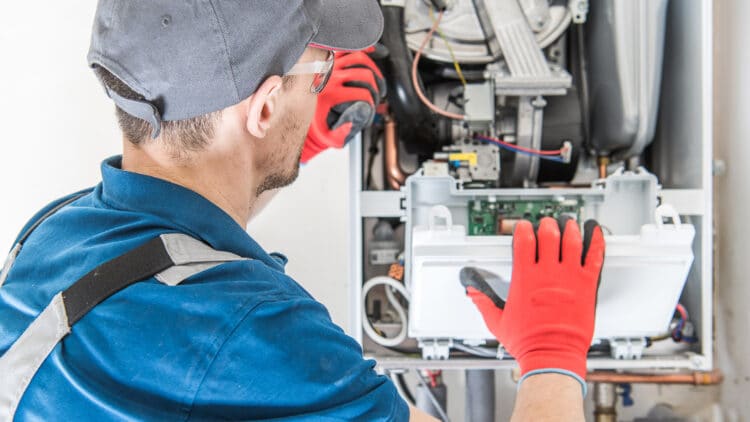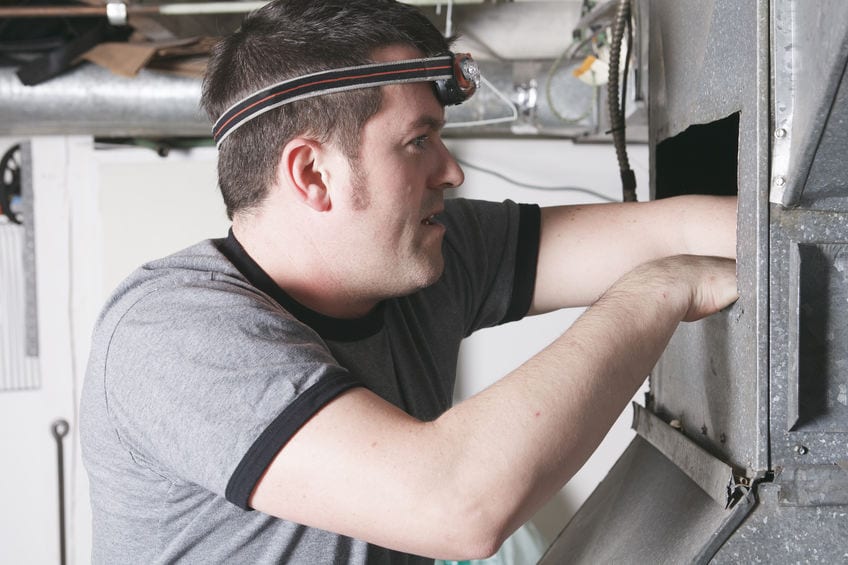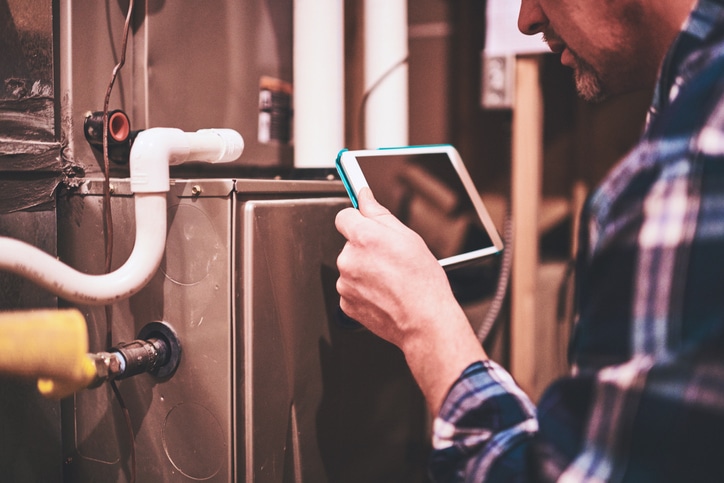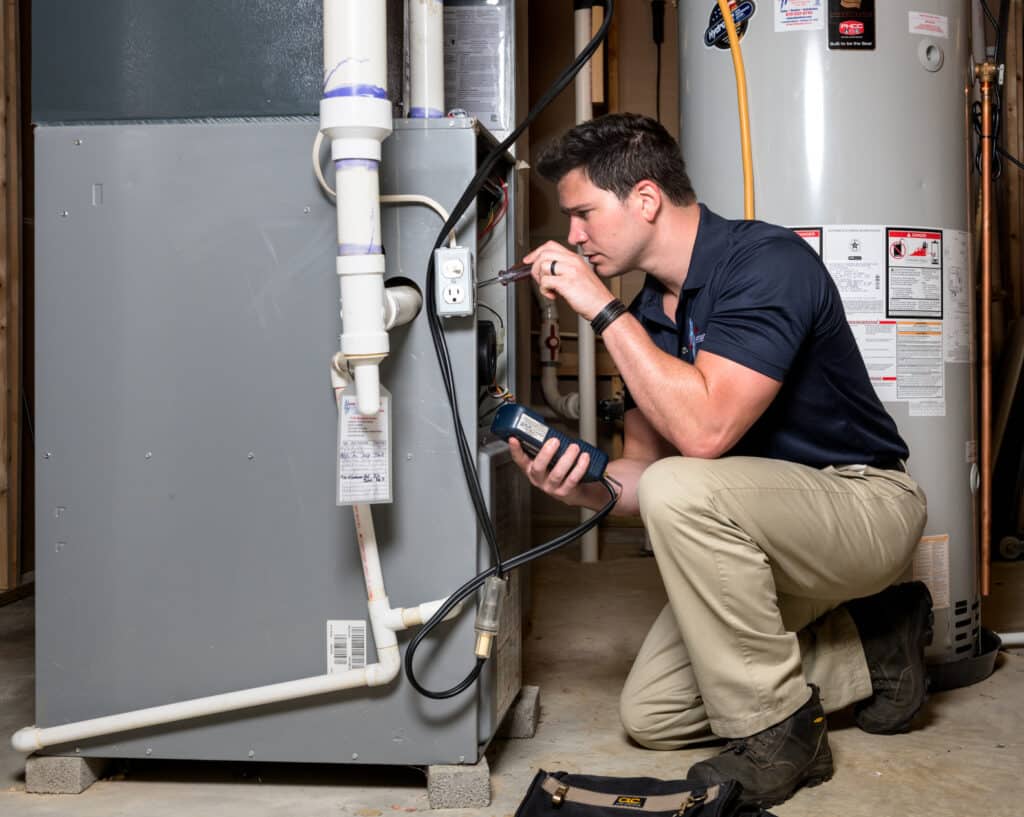Date: May 31, 2023
Installing a furnace, such as a fireplace heater, in a bedroom closet requires careful consideration of safety, efficiency, and the expertise of an HVAC contractor. It’s essential to ensure the water heater is properly installed and a carbon monoxide detector is in place for safety. Proper installation of your average furnace or air furnace ensures the heating unit, whether a fireplace heater or otherwise, functions correctly, maintains temperature control, and adheres to property codes.
This guide outlines essential steps and precautions for situating a heater or fireplace within the confined space of a garage or closet, addressing common issues such as combustion air, ventilation, and access. The post underscores the significance of grasping regional regulations that influence the installation of heaters and fireplaces, especially those fueled by natural gas, in residential areas to ensure room safety and compliance.
By following this guide, homeowners can ensure their heater and fireplace installation, whether using natural gas or not, is both safe and compliant with local conditions, including proper door clearances.
II. Understanding Furnace Installation Basics
Types of Furnaces
Heaters, including natural gas furnaces, come in various types, each with specific installation needs for heating a room efficiently. Ensure the door is properly sealed to maintain warmth. Gas, electric, and oil are the common types of average furnaces you’ll find, often referred to as an air furnace or heater, typically installed near the door. Gas furnaces, often installed near the room door for optimal distribution, are popular heaters known for their efficiency and cost-effectiveness. Electric heaters, including the average furnace, are easier to install but can hike up your energy bill, especially when heating a room. Oil furnaces, when installed in a room, pack a punch in colder climates but require a steady supply of fuel to function as an effective heater.
Each room type demands certain conditions to be met during installation. For instance, when you install gas units in a room, they need a gas line and proper venting to expel exhaust. Electric ones require adequate electrical connections and circuitry support.
Ventilation and Clearance
Safety is not negotiable when installing a furnace in a bedroom closet. Ventilation is crucial in any room; it’s all about keeping the air fresh and safe to breathe when you install proper systems. When you install a heating system in a room, proper clearance ensures nothing combustible is too close to the heat source.

Building codes dictate these installation requirements for your room, so don’t play guessing games with them. A lack of ventilation in a room can lead to dangerous carbon monoxide buildup—no joke there. Consider having a professional install proper ventilation.
Access also matters big time when you install; you gotta have room for maintenance and repairs without doing gymnastics or dismantling your closet.
Professional Installation
DIY might sound cool, but not for furnace installations in your room—leave it to the pros! They’ve got the training, experience, and tools to install it and get it done right. And they’re up-to-date on building codes and install processes that change more often than fashion trends.
A professional installer will consider everything from ductwork design to thermostat placement—details that can make or break your home’s comfort level.
They carry insurance too because sometimes stuff just happens no matter how careful you are during install.
III. Restrictions and Safety Concerns for Modern Furnaces and Fireplace Heater Installation in a Bedroom Closet
When considering the installation of modern furnaces or a fireplace heater in a bedroom closet, it is essential to consult with a professional HVAC contractor. The placement of electric heaters in such an enclosed space must comply with specific codes and regulations to ensure safety. An experienced HVAC contractor can provide guidance on proper installation to prevent potential hazards.
Furnace installations in bedrooms raise red flags due to potential safety risks. Proper installation and maintenance access are crucial for ensuring functionality and emergency response.
Reasons Installations Are Problematic
Installing a furnace in a bedroom closet isn’t always smooth sailing. Trying to install a square peg in a round hole presents issues with space, safety, and building codes. Some places flat-out ban the install, while others wrap it up in so much red tape it’s hardly worth the hassle of installation.
Potential Safety Hazards
The dangers of getting the install process wrong aren’t just headaches; they’re serious business.
Carbon Monoxide Risks
Carbon monoxide is silent but deadly. A small mistake during furnace install can lead to big problems, like carbon monoxide sneaking out if it isn’t vented right. That’s why detectors are must-haves, but even better is avoiding the risk altogether by not putting furnaces where they shouldn’t be, and ensuring proper install protocols are followed.
Fire Hazards
Fire hazards from furnaces are no joke either. Imagine you’re cozy in bed, but your closet furnace starts acting up – that’s nightmare fuel right there. Proper clearance and materials that resist fire can make all the difference between safe dreams and night terrors.
Air Quality Concerns
Then there’s your air quality to think about. Furnaces can kick up dust or other nasties if they’re not installed with care. You want your bedroom air crisp and clean, not feeling like you’re breathing through an old sock.
Accessibility for Maintenance
Maintenance isn’t glamorous, but it’s essential – like flossing. If technicians can’t get to your furnace easily when trouble calls or for regular check-ups, things can go south fast. Plus, if there’s an emergency, having clear access could mean the difference between a quick fix and a full-blown disaster.
IV. Code Regulations Governing Furnace Installations
National codes and local amendments play a pivotal role in furnace installations. They dictate where and how furnaces should be placed to ensure safety and efficiency.
National Codes Standards
The National Fuel Gas Code (NFGC) and the International Residential Code (IRC) set the baseline for safe furnace installation. These documents are like rulebooks, ensuring every contractor plays by the same rules to protect homeowners. The NFGC focuses on fuel gas systems, including furnaces, detailing requirements for combustion air, venting, and clearances from combustibles. The IRC complements this by covering building design aspects that affect furnace placement.

These codes aren’t just suggestions; they’re often adopted into law by states or municipalities. They specify minimum standards for installation practices to minimize risks like fire hazards or carbon monoxide poisoning. For instance, they’ll tell you how much space is needed around a furnace in a bedroom closet for safe operation.
Local Building Codes
Local building codes can tweak national standards based on regional needs. Think of them as customizations to the overarching rules laid out by the NFGC and IRC. These local amendments reflect unique climate conditions, construction styles, or safety concerns specific to an area.
Builders or installers must check with local authorities before proceeding with any work. It’s like asking your teacher if it’s okay to do your project differently because you know something special about your topic that changes things up a bit.
These local codes could restrict placing a furnace in a bedroom closet more than national codes do—or they might allow it with additional precautions in place.
Key Code Elements
Key code elements focus on safety first and foremost. We’re talking about stuff like:
- Clearance: Enough room between the furnace and other objects to prevent fires.
- Accessibility: Being able to reach the unit easily for maintenance or emergencies.
- Ventilation: Proper airflow is critical so that fumes don’t build up.
- Combustion air supply: Ensuring there’s enough fresh air coming in so the flame burns clean.
These code elements are non-negotiables—they’ve got to be met no matter what. If not followed correctly, it could mean trouble down the line—like fines or even dangerous living conditions.
V. Where to Look Up Local Regulations Online
Navigating the maze of building codes for installing a furnace in your bedroom closet can be daunting. But knowing where to look online for local regulations can make all the difference.
Government Building Websites
Your first stop should be government building department websites. These are gold mines for current regulations. They often have sections dedicated to residential construction and heating systems. You might find downloadable PDFs or searchable databases tailored for homeowners.
Here’s what you’ll typically find:
- Permit requirements
- Installation guidelines
- Contact info for further assistance
These sites maintain up-to-date info, crucial since codes can change.
Online Databases
Next up, check out online databases. They compile residential building codes from various jurisdictions. Some popular ones include:
- International Code Council (ICC)
- National Fire Protection Association (NFPA)
They offer resources like:
- Code books
- Subscription services
- Free access to certain documents
Remember, while these databases are comprehensive, ensure you’re looking at the version your local government adopts.
Interpreting Resources
Interpreting building codes isn’t always straightforward. Thankfully, there are resources available to help translate legalese into plain English.
VI. Entities to Contact for Information and Clarification
Seeking clarity on installing a furnace in a bedroom closet requires reaching out to specific entities. They offer vital information and ensure compliance with safety standards.

Local Building Departments
Local building departments are the starting point for information on furnaces in bedroom closets. These departments have the lowdown on what’s hot and what’s not, literally. They’re the gatekeepers of the International Residential Code (IRC) and local amendments that might tweak those rules.
When you get in touch, keep your questions sharp. Ask about ventilation requirements, clearance issues, and any other regulations tied to your plan. They can provide reference documents or even guide you through the process step by step.
Professional HVAC Associations
These groups are like clubs for heating and cooling pros—they know their stuff cold. A professional HVAC association could give you an industry insider’s perspective on best practices for furnace installation.
They might not be as formal as government agencies, but they sure pack a punch of expertise. If there’s a new trend or technology in play, these associations will likely be up-to-speed.
Licensed HVAC Contractors
Now we’re talking about the heavy hitters who can bring heat to your plans—licensed HVAC contractors. These folks aren’t just blowing hot air; they understand how to navigate the codes while ensuring your unit won’t leave you cold.
A licensed contractor has seen it all before. They can spot potential red flags with an eagle eye and suggest solutions that keep you safe without burning through your budget.
VII. Alternatives to Bedroom Closet Furnace Installation
Choosing where to place your furnace is crucial for safety and efficiency. Let’s explore alternatives to the bedroom closet.
Considerations for Location
Safety is paramount when picking a spot for your furnace. Think airflow, convenience, and building codes. Your chosen location must allow for proper ventilation and easy access for maintenance. It should also comply with local regulations which can vary widely.

Noise is another factor. You don’t want a roaring furnace next to your peaceful bedroom. So, consider spots where noise won’t disrupt daily life.
Efficiency matters too. A well-placed furnace operates more effectively, saving you money on energy bills in the long run.
Common Compliant Areas
Now let’s talk about where you can put that furnace instead of the bedroom closet.
Basements are a classic choice. They’re out of the way and often have ample space for installation and servicing.
Utility rooms work great too. They’re specifically designed to house appliances like furnaces, keeping them tucked away neatly.
Garages offer plenty of room but watch out for local codes regarding this option; some areas have restrictions due to potential hazards from vehicle fumes or chemicals stored nearby.
And then there’s attics, though not always ideal due to temperature extremes affecting efficiency and potential difficulty in accessing the unit for repairs or maintenance.
VIII. Recap of the Risks of Installing Modern Furnaces in a Bedroom or Closet
There are significant risks associated with placing modern furnaces, such as fireplace heaters or electric heaters, in confined spaces like a bedroom or closet. One primary concern is the potential for carbon monoxide poisoning, which can occur if these heating units are not properly installed and ventilated. It’s crucial to consider these dangers when choosing the location for your heating system.
Health and safety risks, along with legal consequences, are significant considerations when installing a furnace in a bedroom closet. It’s crucial to understand these risks thoroughly.
Health and Safety Risks
Putting a furnace in your bedroom closet isn’t just about saving space; it’s a decision that could affect your health and safety. Furnaces need proper ventilation to prevent dangerous gases like carbon monoxide from building up. If you’re sleeping right next door to it, even small leaks can be harmful over time.
The risk of fire is also higher when furnaces are squeezed into small spaces not designed for them. Closets typically have clothes, bedding, and other flammable items that could catch fire if the furnace malfunctions or overheats.
Furthermore, noise pollution is an often-overlooked issue. A furnace kicking on throughout the night can disrupt sleep patterns, leading to fatigue or more serious health issues over time.
Legal Implications
Installing your furnace in unconventional spaces like closets might seem like no big deal until you hit legal snags. Building codes are there for good reasons—primarily your safety—and ignoring them can lead to hefty fines or even criminal charges.
There’s also the matter of home insurance policies that require code compliance for coverage. If something goes wrong with an illegally installed furnace, you could be footing the bill for all damages out-of-pocket.
In addition to fines and insurance woes, selling your house can become a nightmare if you’ve got code violations hanging over your head. Potential buyers aren’t keen on inheriting legal problems or unsafe living conditions.
IX. Best Practices for Ensuring a Safe and Compliant HVAC Contractor Furnace Installation
When installing a furnace, which may include a fireplace heater, always ensure there is an adequate combustion air source. This is crucial for both safety and efficiency. Additionally, when working near other appliances like a water heater, ensure that all installations are compliant with local codes and regulations.
Ensuring the safety of a furnace in a bedroom closet hinges on professional installation and diligent upkeep. Carbon monoxide safety and adequate space clearances are non-negotiable.
Working With Licensed Professionals
The cornerstone of any safe furnace installation is hiring licensed professionals. They have the training, experience, and knowledge to ensure that every aspect of your furnace setup complies with local codes and safety standards. These pros navigate permits like pros, so you can sleep easy knowing everything’s up to snuff.
An expert installer brings more than just tools—they bring peace of mind. They’ll size up your closet space, recommend the right equipment, and tweak your setup for optimal efficiency. Think of them as your personal home comfort wizards.
Regular Maintenance and Inspections
Like clockwork—your furnace needs regular check-ups to run smoothly. An annual inspection by a certified technician can catch little hiccups before they turn into full-blown meltdowns. It’s all about nipping potential problems in the bud.

Maintenance isn’t just about avoiding breakdowns; it’s also key to keeping running costs down. Clean filters? Check. Tight connections? Double-check. A well-oiled machine keeps those energy bills from soaring through the roof.
Installing Carbon Monoxide Detectors
Safety first—always! Installing carbon monoxide detectors near your bedroom closet furnace is like having a silent guardian watching over you 24/7. These little lifesavers will alert you at the first whisper of danger, long before it becomes a shout.
And let’s talk clearances—keeping stuff away from your furnace isn’t just good sense; it’s critical for safety and efficiency. There should be enough room around it for proper airflow and maintenance access—a cramped closet won’t cut it.
X. Frequently Asked Questions
A. Common Queries About Furnaces
Homeowners often ponder the safety and logistics of installing a furnace in a bedroom closet. Concerns revolve around space, ventilation, and building codes.
Furnaces require proper clearance for operation and maintenance. They must have enough room to “breathe” and function without risk. The question isn’t just about fitting it in; it’s about long-term safety.
Ventilation is another critical factor. Bedroom closets aren’t typically designed with furnaces in mind, so ensuring adequate airflow is paramount.
Local building codes are the rulebook for furnace installations. These regulations dictate where and how you can install a furnace safely in your home.
B. Answers to Guide Safe Choices
Choosing the right spot for your furnace involves more than convenience. It’s about adhering to guidelines that keep you safe.
Firstly, always check with local authorities on code requirements for furnaces in closets. This step is non-negotiable as compliance ensures safety.
Secondly, consider hiring a professional HVAC technician for advice and installation. Their expertise can prevent potential hazards associated with improper installation.
Thirdly, ensure there’s sufficient clearance around the furnace as specified by both the manufacturer and local codes. Cramped spaces can lead to dangerous situations.
Lastly, regular maintenance is crucial for any furnace but especially one in an unconventional location like a bedroom closet. Schedule inspections to catch issues early on.
XI. Resources
Having wrapped up the main discussion on the placement of a furnace in a bedroom closet, it’s crucial to have the right resources at hand for further guidance and professional support.
Local Contacts
Finding reliable local departments and HVAC professionals is key. They offer expertise in installation, maintenance, and safety protocols for your furnace. Whether your energy source is electricity, oil, or another option, these pros know their stuff.
They’ll ensure your setup meets local codes and runs efficiently. It’s smart to keep a list of contacts handy for quick reference. This could include the local building department, trusted HVAC service providers, and emergency contacts.
Building Codes Online
Building codes can be a maze of technical jargon. But they’re vital for your safety. Online resources demystify these regulations, making them accessible to homeowners.
Websites like the International Code Council (ICC) provide updates on building codes related to HVAC systems. These resources help you understand what’s required for your furnace installation, including those using water sources or other energy types.
Further Reading
Knowledge is power, especially. Recommended reading materials can expand your understanding and keep you informed about best practices.
Look for books and articles by industry experts that cover topics from basic maintenance to advanced system troubleshooting. They can also delve into the specifics of different energy sources used in furnaces.
In conclusion, equipping yourself with a robust list of contacts, online code resources, and educational reading material will ensure you’re prepared for anything regarding your furnace in the bedroom closet. Remember that safety and compliance with local regulations are paramount when dealing with any energy source within your home.

